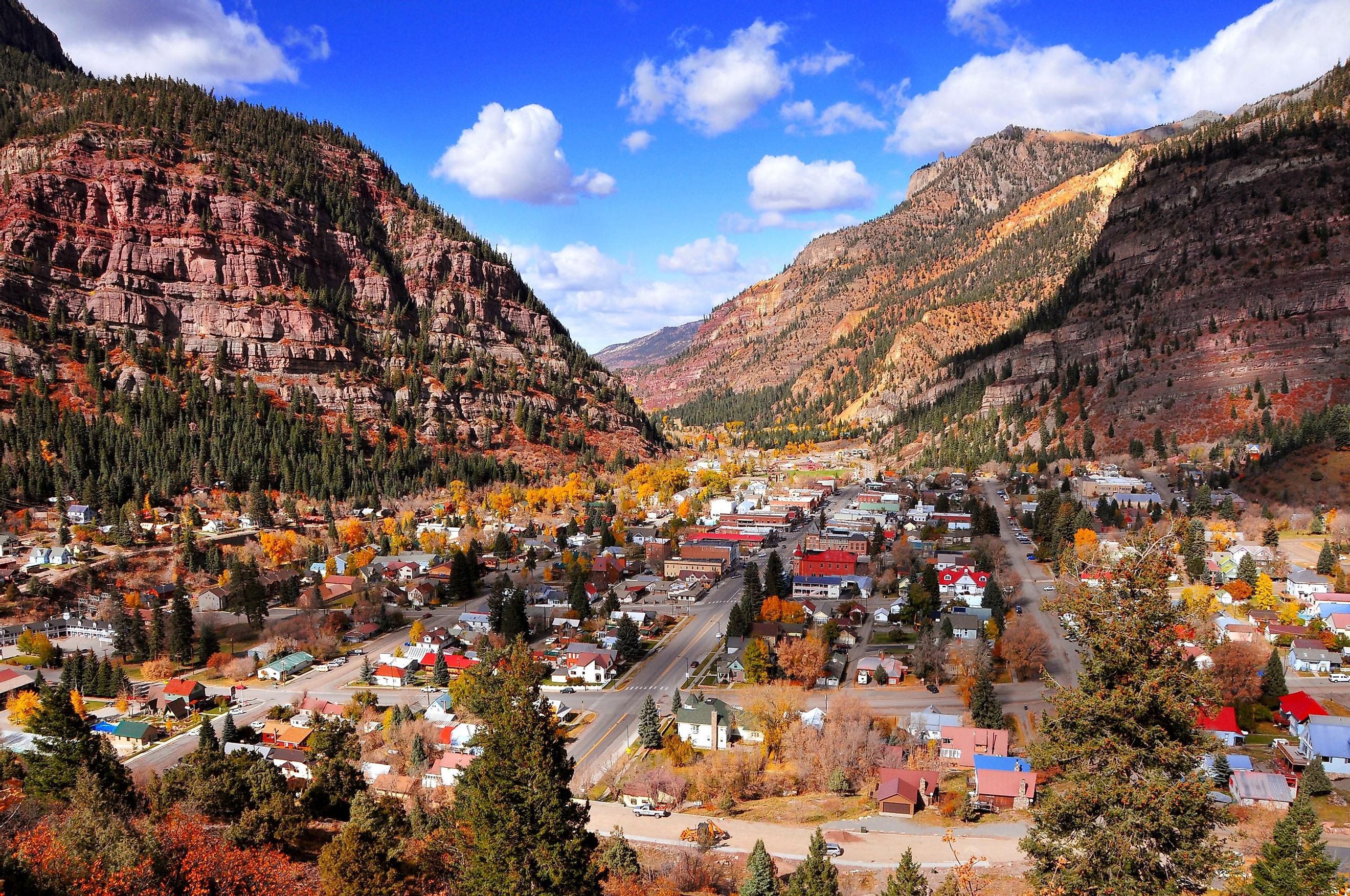
These Small Towns In Colorado Come Alive In The Fall
Of the 91 mountain peaks in the United States whose height reaches 14,000 feet, 56 exist within the borders of Colorado. Even the state’s “smaller” peaks are plentiful, over 1,000 of which rise 2 miles high. It is no surprise, then, that Colorado is a world-famous ski destination, luring millions from near and far to its iconic resorts. But before the mountainsides open for their winter season, Colorado’s mountain towns come alive in the fall. From September through October, vibrant aspens transform from green to gold, brightening the shores of Rocky Mountain lakes and San Juan Mountain road trip routes. This fall, explore Colorado’s mountain towns to experience autumn colors, sights, and scenes like no other.
Aspen
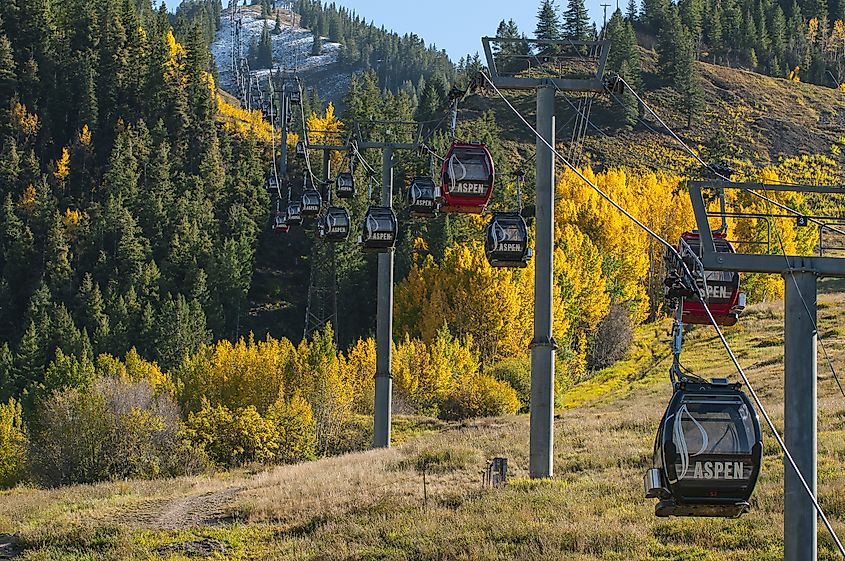
If you are on the hunt for the best Colorado towns to visit in the fall, you have probably seen the ski resort town of Aspen pop up a few times–and for good reason. The town’s name is your first clue as to why it is so popular during autumn. Although the area’s peak foliage is tricky to predict, a visit to Aspen from September to October is when your chances are best at spotting the iconic yellow trees the town was named after. Generally, if you visit by the 3rd week of September, your visit will be golden, but even if the trees are past their prime, the yellow leaves are still enchanting underfoot.
On the other hand, if you find the colors are not at their peak during your visit, locals suggest heading to higher altitudes in the mighty Rocky Mountains. The higher you go, the sooner the leaves transform, so you may just find a few glorious pockets of aspen trees in their full golden glory. Bear in mind that while this resort town is primarily famous for its world-class skiing in the winter, you will still see a fair amount of crowds in the fall, especially at more popular trails. Paths like the Cathedral Lake and Hunter Creek trails are pretty busy during the weekends due to their gorgeous fall foliage, so a weekday visit is your best chance at avoiding heavy foot traffic.
Snowmass
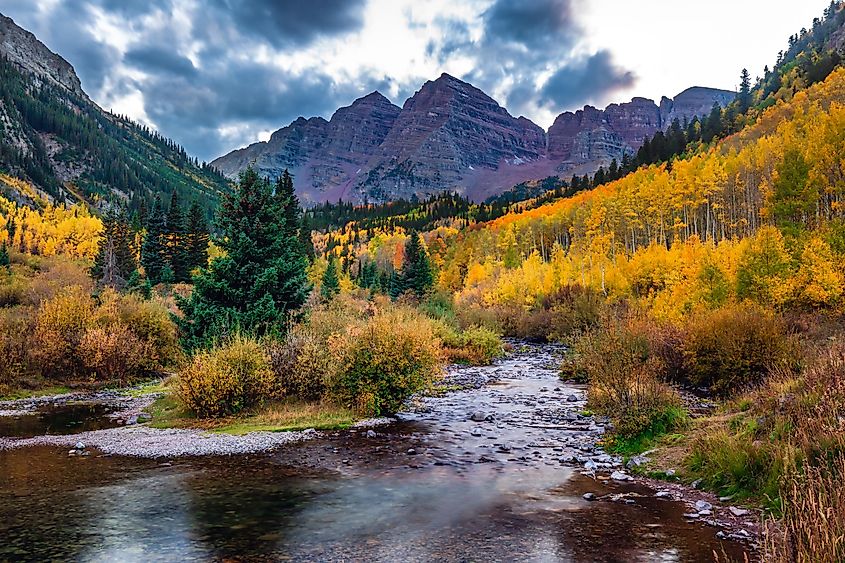
Leaf peeping is also popular in the nearby town of Snowmass, whose bright yellow trees are equally vibrant in the fall. For some truly bucket-list-level fall foliage, visit the nearby Maroon Lake and Maroon Bells Region. The 14,000-foot peaks (named for their bell-like shape) are one of Colorado’s most iconic (and most photographed) landforms. And although the glacial valley destination is gorgeous year-round, many say fall is the best time to visit. The reflective lake becomes illuminated with the colors of the season, creating a truly stunning autumn scene fit for a postcard.
It is worth noting that Aspen is actually a tad closer to the Maroon Bells Region, just 10 miles from the peaks, while Snowmass is a bit further, at 16. However, some prefer Snowmass as a gateway to adventure for its quieter, family-focused atmosphere. While both towns have endless nature opportunities for the whole family to enjoy, Aspen offers more in terms of nightlife. In contrast, Snowmass is a great choice for those looking for a quieter mountain getaway.
Estes Park
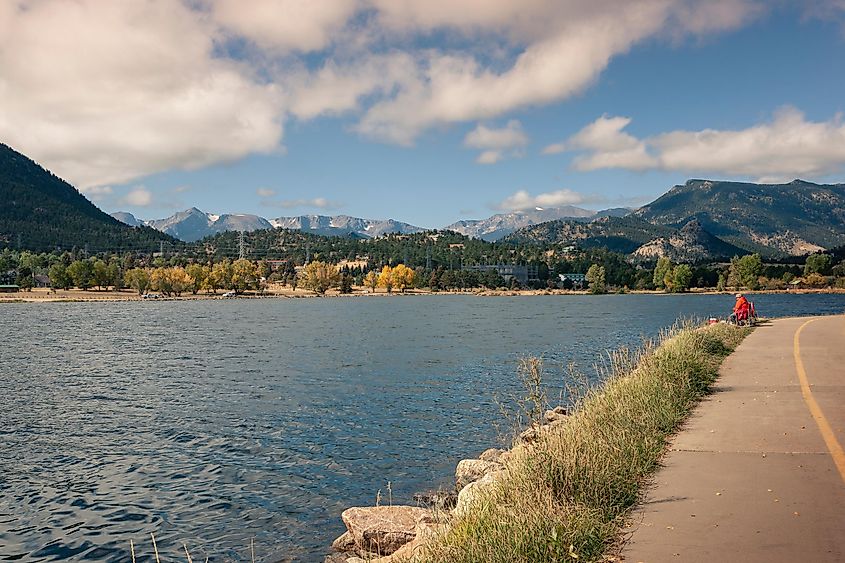
Making your way deeper into northern Colorado, Estes Park is another Rocky Mountain town whose community comes alive during the fall. While many visit for the surrounding nature, Halloween devotees also find themselves lured to this mountain town for its iconic landmark: The Stanley Hotel. Built in 1909, the hotel’s 155 rooms have hosted names like Theodore Roosevelt and Bob Dylan. But what truly entices the hotel’s curious guests is its paranormal reputation. Even more intriguing, this supposedly haunted hotel only increased in popularity when it starred as the ominous setting in the box office darling, The Shining. Today, horror enthusiasts continue to visit year-round, but especially in the fall, in the hopes of experiencing the very place that spooked Stephen King himself.
For a less spooky (yet all the while exhilarating) attraction, the town’s main claim to fame is its eastern entrance of the Rocky Mountain National Park. With 3 million people visiting the national park every year, Estes Park locals are used to sharing their town with the park’s visitors, especially during its peak months in the summer and fall. Autumn is an especially exciting time in the park, with wildlife spotting at an all-time high. As the weather cools, elk migrate to lower elevations and are more likely to be seen. They are even more commonly heard, their calls ringing throughout the park.
Keep in mind that the park’s foliage is also usually vibrant by late September into October, with oranges and yellows scattered throughout. Trails like the Deer Mountain path offer the best of both worlds: elk and deer are commonly spotted, with aspens and other fall foliage dotted along the way. The 6-mile hike is steep, but the views from the Deer Mountain peak are well worth the effort.
Grand Lake
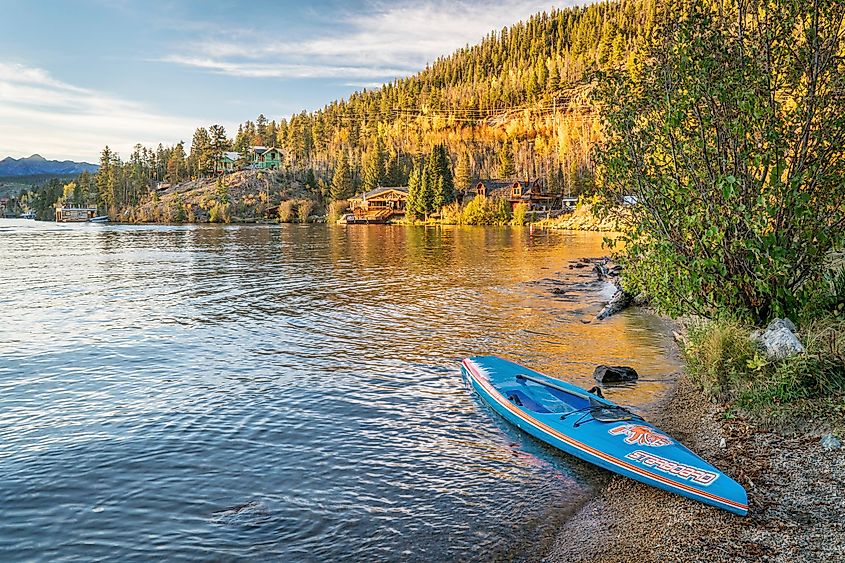
Around 1.5 hours from Estes Park, the town of Grand Lake is another fantastic home base for accessing the Rocky Mountain National Park. The town is settled near the national park’s western entrance, which is known for being somewhat of an underrated gem. The western entrance, or “Grand Lake entrance,” as many call it, is one of the least busy. So if you are looking to explore nature in secluded bliss, let Grand Lake guide you through. But do not mistake the easygoing entry for unexciting views. The western end of the park opens you to incredible hikes and sights, including the Colorado River’s headwaters and the challenging 13.5-mile Lake Verna hike (known for being one of the park’s most scenic bodies of water).
If you would prefer a closer alpine lake, minus the strenuous hike, stay in town! Grand Lake’s namesake spans over 500 surface acres, making it the largest natural reservoir in Colorado. While the lake is mainly bordered with evergreens, the vibrant aspens cannot be missed. The historic Grand Lake boardwalk is a great way to spot a variety of aspens while taking in the mountain backdrop and shimmering lake.
Golden
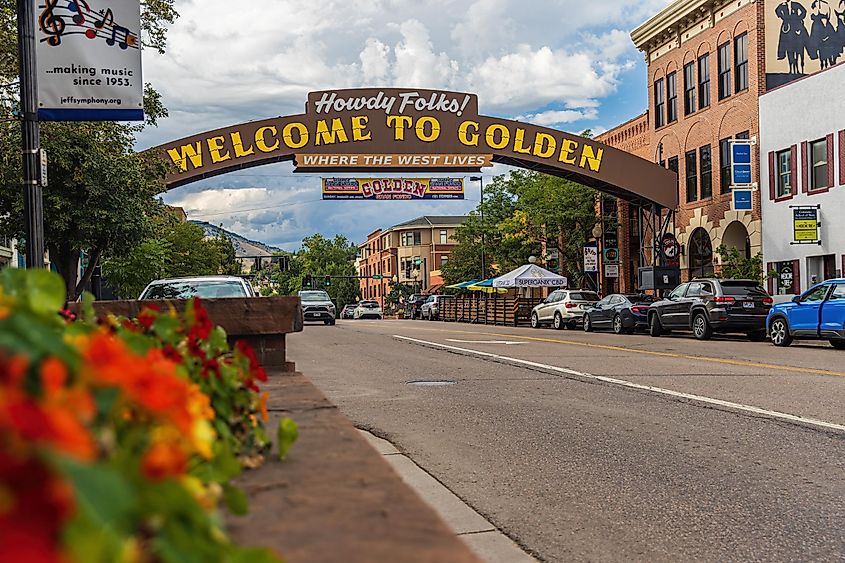
In the foothills of the Rocky Mountains, the scenic town of Golden invites endless adventure, acting as a gateway to Colorado’s 3rd largest State Park. The Golden Gate Canyon State Park is a 12,000-acre area, whose land welcomes over 1.5 million visitors each year, and it is just 14 miles from Golden. With 36 miles of trails, 152 campsites, 6 cabins, and even a horse-friendly guesthouse, Golden Gate is an outdoor haven for any type of adventurer.
The park is heavily forested in evergreens, but like other Rocky Mountain zones, you will find the white-barked, yellow-leaved aspens spotted throughout. For views of towering old-growth aspens in the fall, make your way to the Bootleg Bottom picnic area from the Mule Deer Trail. Alternatively, the moderately challenging Racoon Trail will also guide you through a winding aspen-lined path with a 141-m elevation gain to Panorama Point. Take in the views of the snow-capped peaks in the distance, and behold how massive this park truly is.
Rifle
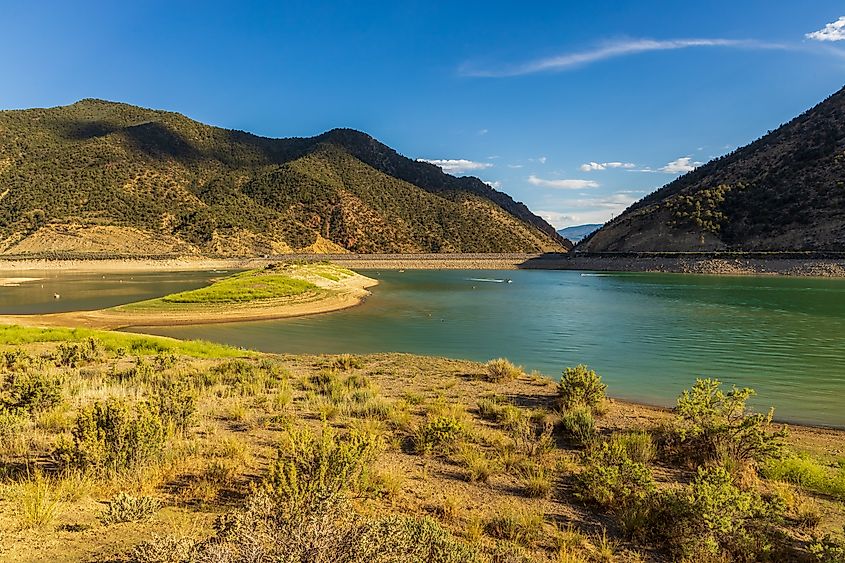
Rifle, Colorado, is another small town with a tremendous gateway to nature in the fall. At first glance, it may look like any other Colorado town with pretty seasonal foliage, but its location is key. Not only is it settled along the scenic Colorado River, but you will find yourself within a short driving distance of 3 impressive mountain parks. The furthest, Rifle Mountain Park, has an affordable $5 USD entry fee that grants you access to some of the best limestone rock climbing in North America.
Less than 30 minutes north of town, you can also find yourself between the other two parks: the Rifle Gap State Park and Rifle Falls State Park. Rifle Gap’s 350-acre alpine reservoir is a hotspot for water recreation in the summer and makes for a lovely loop hike in the fall. Rifle Falls, on the other hand, is a great way to take in the region’s fall foliage, the park’s lush greenery transformed with the season’s hues. But the park’s true crown jewel is the 60-foot triple-cascade, whose year-round flow may be slightly slowed in the fall but is still a sight to behold. Brave explorers can also venture beneath the falls from the Coyote Trail to explore the park’s fascinating limestone cave system.
Walden
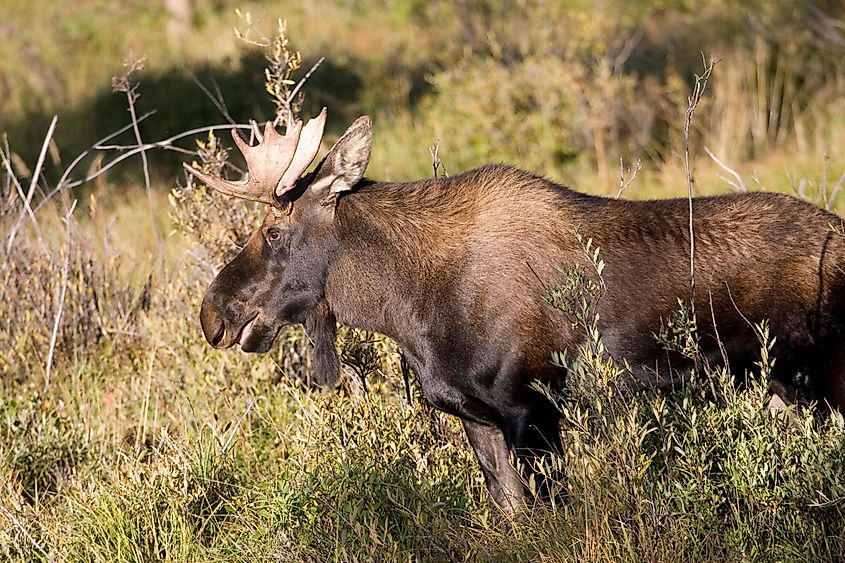
Heading further into northern Colorado, Jackson County is home to Walden, the “Moose Viewing Capital of Colorado”. This sub-alpine valley town is located in North Park, a high-elevation basin whose rolling hills and wetlands allow the local moose population to thrive. Three main tributaries of the North Platte River (the Illinois, Michigan, and Canadian rivers) run through North Park, meaning the area is not only scenic but also brimming with wildlife.
A visit to Walden in the fall also grants you access to the largest state park in the state: the State Forest State Park. The park is just a short drive from Walden, located in the Medicine Bow Range of the Rocky Mountains. It reaches across 71,000 acres, with 95 miles of hiking trails to discover. Thick, coniferous forests cover around 52,000 of those acres, and bright aspens can also be seen speckled throughout. But moose spotting, of course, is one of the park’s more exciting features. If you are hoping to catch a glimpse of the majestic animals, make sure to stop by the park’s Moose Visitor Center to stock up on tips, tricks, and exhibits.
Ouray

Last but certainly not least, the San Juan Mountains invite you to embrace the reds, yellows, and browns of Ouray’s autumn season. The drive into town is enchanting in itself, with vibrant maples, aspens, and oaks contrasted against the snow-capped backdrop. The Million Dollar Highway is one of Colorado’s most scenic road trip routes, and Ouray is an excellent nearby destination or rest stop. The fall foliage continues into town, lining the streets and banks of the beautiful Uncompahgre River, whose waters flow through Ouray.
Nestled amongst the trees, fight the chill fall breeze with a dip at one of Ouray’s luxurious hot springs. With four properties to choose from (Box Canyon Lodge and Hot Springs, Ouray Hot Springs Pool, Twin Peaks Lodge and Hot Springs, and Wiesbaden Hot Springs Spa & Lodging), these year-round sites are a romantic way to enjoy the outdoors without bundling up.
Between its towering mountains, glistening alpine lakes, and evergreen forests dotted with aspen groves, Colorado is a nature lover’s paradise year-round, but fall truly takes on a life of its own. Whether you are hiking the peaks at Rocky Mountain National Park or taking a scenic road trip through the San Juan Mountain range, Colorado’s seasonal hues are a testament to the season’s splendor. These small Colorado towns are not only some of the best fall destinations in the state but perhaps some of the greatest in the country. Bundle up, lace up your running shoes, and take advantage of Colorado’s outdoor playground this fall.











